Best Sourdough Flatbread Recipe (rectangle-shaped for pizza)
This sourdough flatbread recipe is perfect for making pizzas and appetizers. It’s got the texture of a pizza crust when baked and takes only a few minutes in the oven. We love adding homemade bbq sauce and shredded chicken to make grilled flatbread pizzas! This recipe post includes a video tutorial so you can make it alongside me, step-by-step!
This post may contain affiliate links of items I know and love. Read our disclosure policy for more information. I NEVER use AI (artificial intelligence) to create content for Plum Branch Home. Recipes, blog posts, photos, videos, podcasts, social media content: everything is made from scratch by me, Molly LaFontaine. After developing my recipes, they’re tested 2x by my husband, Tyler, and I before publishing. What you see from Plum Branch Home is real. It’s made for a reason, tested, and loved!
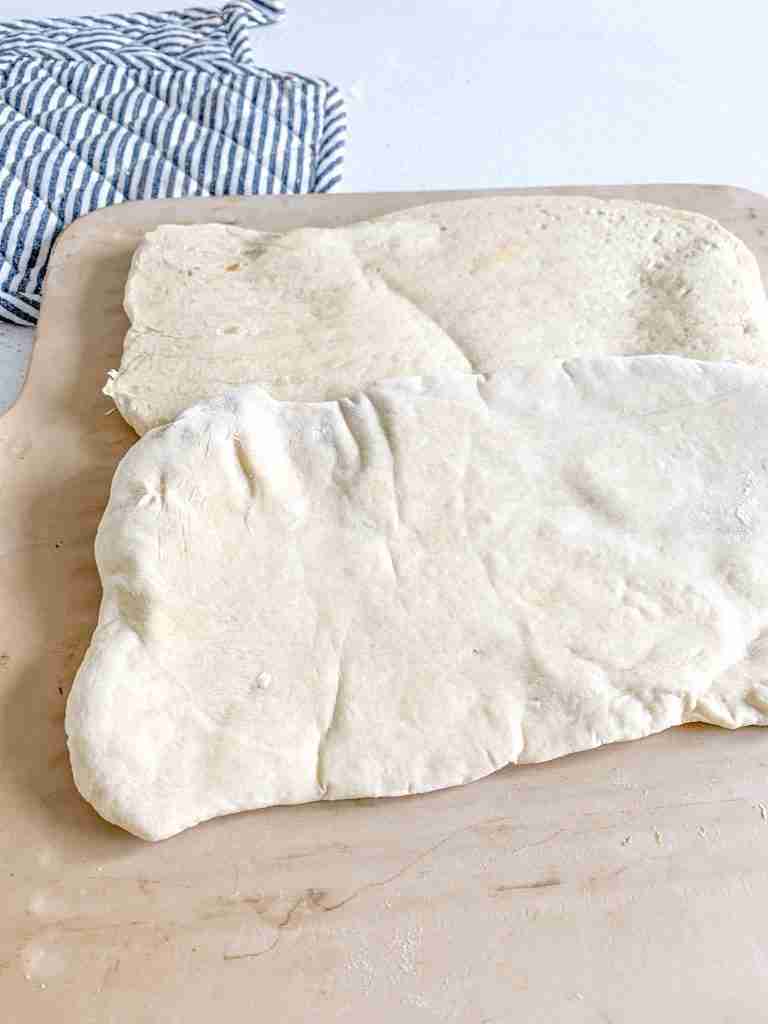
If you want to make this recipe but don’t have a sourdough starter, no worries! Grab my free guide so you can make your own starter at home.
If you’re new to sourdough baking and feel hesitant, or you have questions, I’ve got something for you! I broke down the basics of what you need to know about sourdough baking in my free sourdough baking guide for beginners. I highly recommend grabbing a copy!
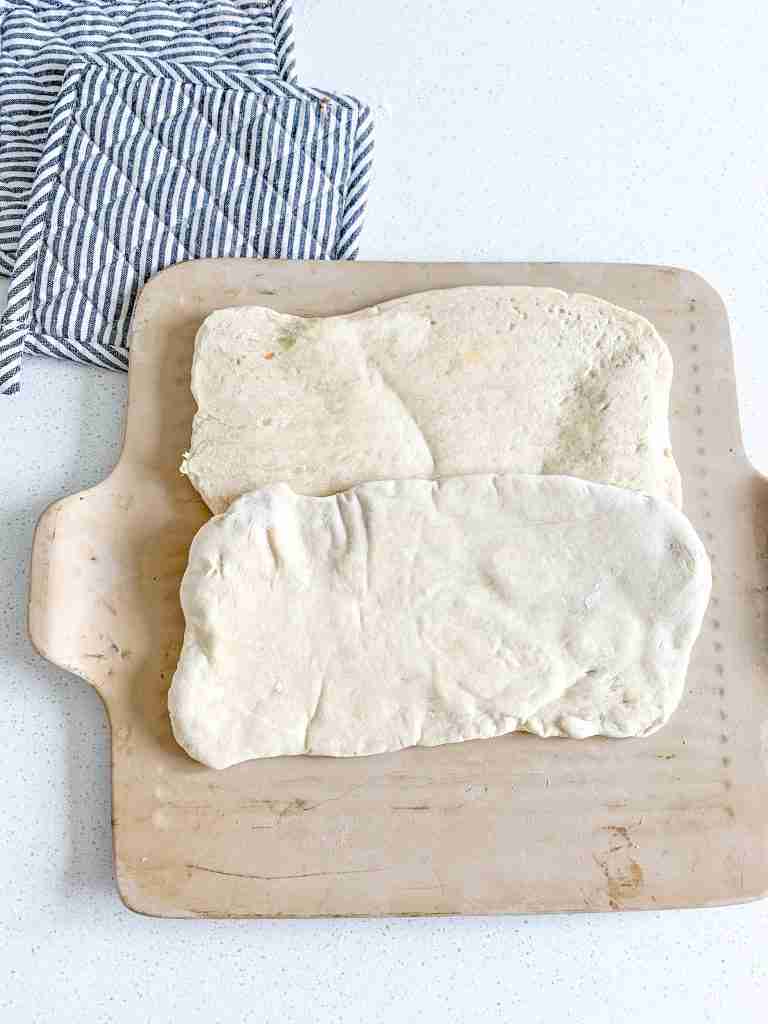
Why You’ll Love This Sourdough Flatbread Recipe
- Easy to Make: The steps are so simple to follow.
- Wholesome Ingredients: I use wholesome staples such as raw honey and sea salt to keep this recipe nourishing.
- Multiple Uses: You can use this flatbread to make pizza, an appetizer, or use it as a side.
- Rectangle Shape: This recipe mimics the Subway flatbread shape.
What Makes This Recipe Easy?
- Simplified Steps: Each step is simplified, so it’s easy to follow.
- Grouped Actions: I’ve grouped the steps together so you can easily see the different actions.
- No Nonsense: There are zero unnecessary steps in this recipe.

Ingredients You’ll Need
- salt: I always like to use sea salt
- fed sourdough starter: be sure your starter is active and bubbly
- water: this hydrates the dough
- avocado oil: you can also use olive oil or melted butter
- raw honey: you can also use pure maple syrup or granulated cane sugar
- all-purpose flour: I like to use unbleached, organic
Helpful Kitchen Tools for this Recipe
This section contains Amazon affiliate links to items I use and love for this recipe.
How to Make This Easy Sourdough Flatbread Recipe
How to Prepare Your Sourdough Starter
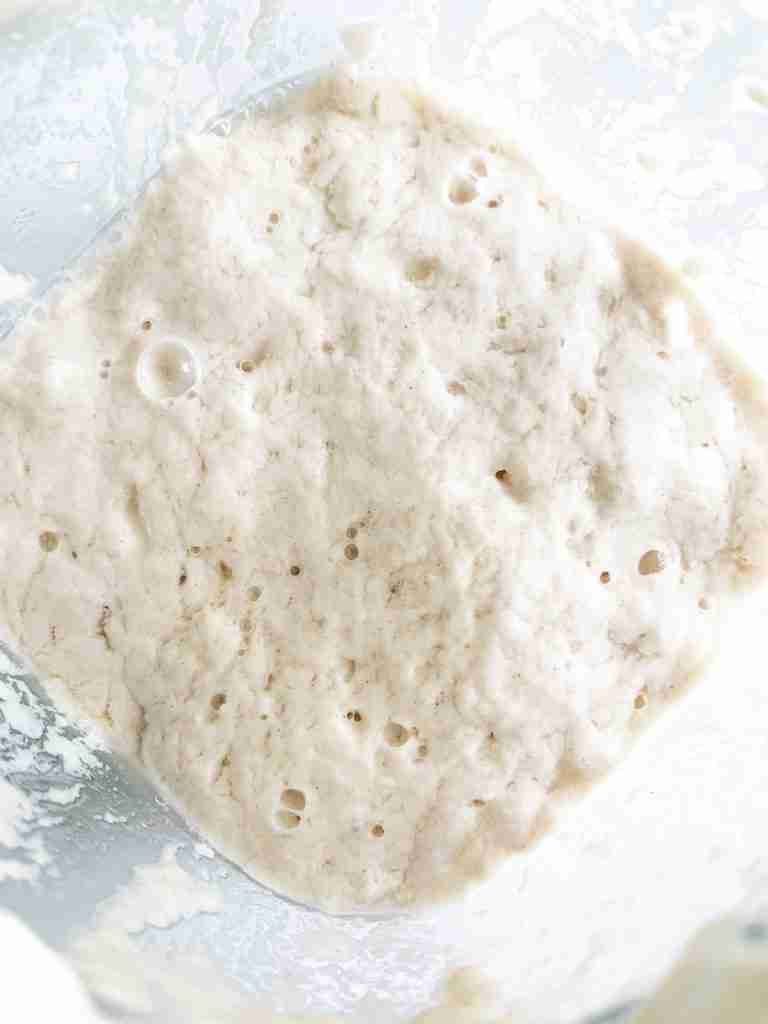
BEFORE YOU GET STARTED: Feed your entire sourdough starter jar4-12 hours before starting this recipe. I recommend feeding your entire starter a 2:1 ratio of unbleached flour to filtered water to get the same results as I do when making this recipe.
(Example: Feed entire starter 1 cup flour + 1/2 cup water and let it sit on the counter at room temperature until it’s bubbly and has grown in the jar. Your starter needs to be active, bubbly, and a thicker consistency to use in this recipe.)
Make the Easy Sourdough Flatbread Dough

In a large bowl, mix together salt, sourdough starter, water, avocado oil, and honey until combined.

Add in flour and mix until the dough is shaggy. The texture will depend on the hydration of your starter.
Use your hands to bring the dough together with your hands into a ball.
Knead the Dough

Turn the dough out onto the counter; no flour is needed at first. Knead the dough for 2-3 minutes. Add a little flour if the dough does get sticky.
Then place it back in the mixing bowl and cover loosely with a towel, lid, or plastic wrap.
Bulk Ferment the Dough
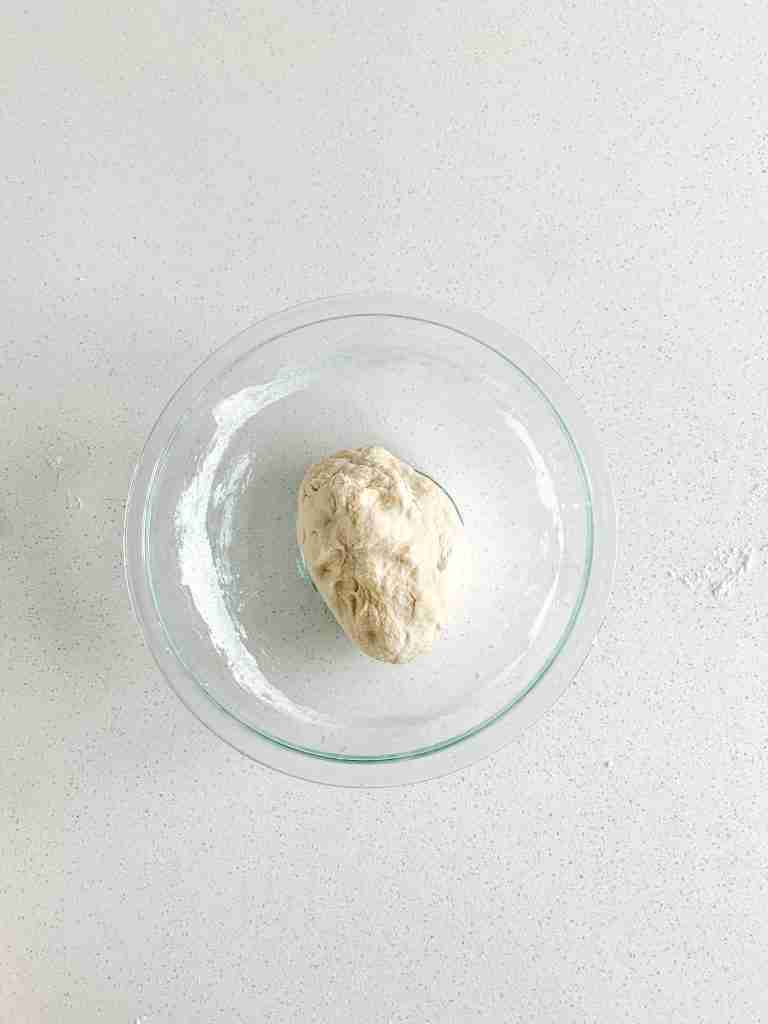
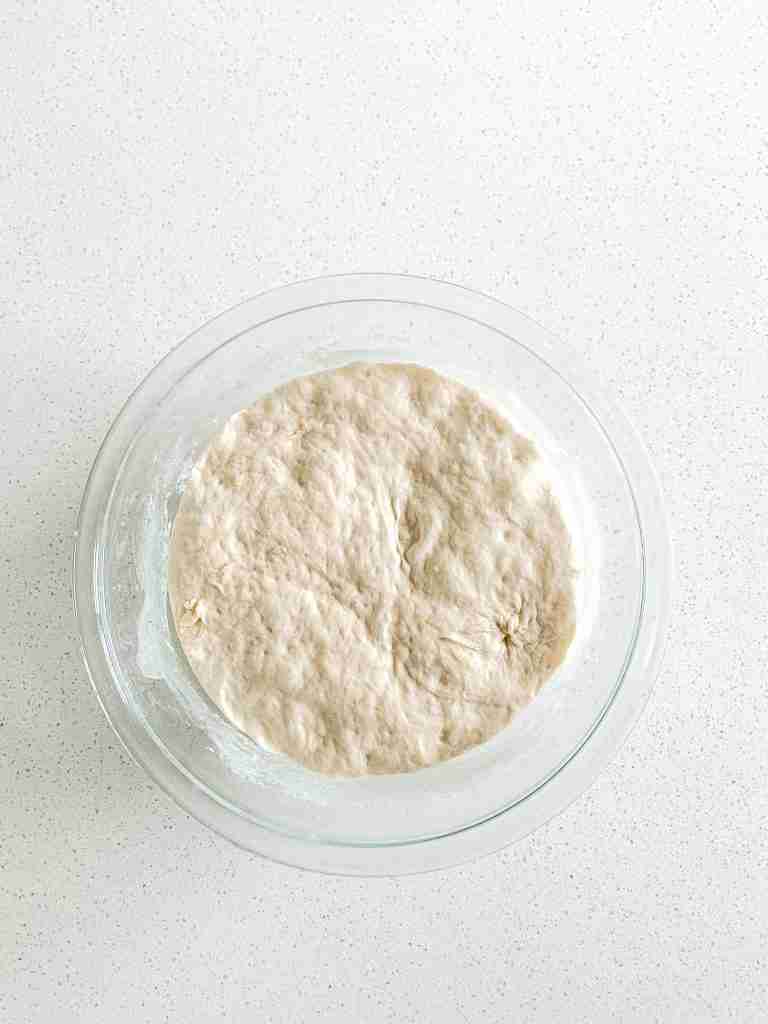
Let the dough ferment at room temperature for 10-12 hours until it has doubled. Please see notes below!
Optional: Once the bulk fermentation is finished, place the dough in the fridge for up to 24 hours if you want more gut benefits or need more time before baking.
Prepare to Bake
Preheat the oven to 425 degrees with a pizza stone or sheet pan inside.

To continue the recipe, turn the dough out on the counter. Add a little flour if needed to prevent sticking.
Roll out the Flatbread Dough

Cut the dough into 2 pieces.

Roll one dough piece out into a rectangle about 1/4 of an inch thick. Repeat with the second piece.
Bake the Flatbreads

Place both rolled out dough pieces on the preheated pan or stone and cook for 5 minutes.

Then flip the flatbreads and cook on the other side for 5-7 minutes.
Remove when the dough is fully cooked. Let cool and enjoy!
Video Tutorial
Storage Instructions
Store cooled down flatbreads in an airtight container or baggie for 3-5 days at room temperature. I always prefer folding them in half and storing them in a glass container.
How to Freeze & Thaw Sourdough Flatbread
Freezing Instructions: Freeze completely cooled flatbread in a freezer-safe container or baggie for up to 3 months.
Thawing Instructions: When you’re ready to thaw, place the flatbreads in the fridge or on the counter at room temperature overnight.
Best Way to Reheat Flatbread
Warm baked flatbread in the oven at 325 degrees Fahrenheit for 3-5 minutes or until warm.

How to Serve Sourdough Flatbread
You can eat flatbreads in so many ways! For my particular rectangle sourdough flatbread, I like to use it like this:
- As a pizza crust (that you can grill or bake)
- Serve it warm and eat it as a side
- Pile on different toppings and make it an appetizer

Molly’s Tips for the Best Sourdough Flatbread
- Make sure your starter is active! BEFORE YOU GET STARTED: Feed your starter 4-12 hours before starting this recipe. I recommend feeding it a 2:1 ratio of unbleached flour to filtered water to get the same results as I do when you make this recipe.
- Let the dough bulk ferment for 10-12 hours, don’t rush it! It is important to let your dough bulk ferment for the full 12 hours. It should double in size and have air bubbles in it.
- Place the dough in a warm spot to rise. For the bulk ferment, your dough needs to be at room temperature in a non-drafty place.
- Make sure the pan or stone is in the oven during preheating. This ensures it is hot and ready to bake your flatbreads.
FAQs
I recommend using fed starter so your dough will bulk ferment. If you choose to use discard, simply add it in place of the fed starter. Just know your dough won’t double in size like the recipe says.
A sourdough naan is more soft and chewy, whereas sourdough flatbread is more flat and has a pizza crust texture.
More Sourdough Bread Staple Recipes
- Sourdough Tortillas
- Sourdough Naan (brushed with garlic butter)
- Sourdough Hot Dog Buns
- Soft Sourdough Brioche Buns
- Sourdough Pita Bread
If you made this recipe, give it a 5-star rating below and share a photo on your social media stories! Be sure to tag @plumbranchhome
Recipe

Sourdough Flatbread (rectangle-shaped for pizzas)
Ingredients
- 1 tsp salt
- 1/2 cup fed sourdough starter
- 1/2 cup water
- 1/2 Tbsp avocado oil (or melted butter)
- 1/2 tsp raw honey (or pure maple syrup)
- 1 1/2 cups all-purpose flour
Instructions
Prepare Your Starter
- BEFORE YOU GET STARTED: Feed your entire sourdough starter jar 4-12 hours before starting this recipe. I recommend feeding your entire starter a 2:1 ratio of unbleached flour to filtered water to get the same results as I do when making this recipe. (Example: Feed entire starter 1 cup flour + 1/2 cup water and let it sit on the counter at room temperature until it’s bubbly and has grown in the jar. Your starter needs to be active, bubbly, and a thicker consistency to use in this recipe.)
Mix Ingredients
- In a large bowl, mix together salt, sourdough starter, water, avocado oil, and honey until combined.
- Add in flour and mix until the dough is shaggy. The texture will depend on the hydration of your starter.
- Use your hands to bring the dough together with your hands into a ball. Add 1-2 Tbsp extra water if needed.
Knead the Dough
- Turn the dough out onto the counter. Knead the dough for 2-3 minutes. Add a little flour if the dough starts to stick.
- Place dough back into the mixing bowl and cover loosely with a damp towel, lid, or plastic wrap.
Bulk Ferment
- Let the dough ferment at room temperature for 10-12 hours until it has doubled in size. Please see notes below!
- Optional: Once the bulk fermentation is finished, place the dough in the fridge for up to 48 hours if you want more gut benefits or need more time before baking.
Prepare to Bake
- Preheat oven to 425 degrees Fahrenheit with a pizza stone or large sheet pan inside.
Shape Flatbreads
- To continue the recipe, turn dough out on the counter. Dust counter with flour if dough is sticking.
- Cut dough into 2 equal pieces.
- Roll one dough piece out into a rectangle about 1/4 of an inch thick. Repeat with the second piece.
Bake Flatbreads
- Place both rolled out dough pieces on the preheated pan or stone (if there’s room so they don’t touch) and bake for 5 minutes.
- Then flip the flatbreads and cook on the other side for 5-7 minutes.
- Remove when the dough is fully cooked. Let cool and enjoy!
Video

Notes
- If your dough doesn’t look like it’s doing anything halfway through the rises, you need to place it in a slightly warmer area.
- This can be in a turned-off oven with the light on and oven door open, or you can slightly warm the oven to about 75-80 degrees Fahrenheit, then turn it off and place your dough inside with the door shut.
- Never leave the oven on, even on the keep warm setting, with fermenting dough inside. Your dough, for both rises, needs to double.
- If your dough doesn’t double even in the warmer area, there is a problem with your starter. It is too weak to ferment the dough even in a warm environment.
- To fix this, you will want to leave your starter out on the counter for 2 days and feed it every 12 hours at a 2:1 ratio of unbleached flour to filtered water.
- For example, 1 cup unbleached flour + 1/2 cup filtered (or bottled) water.
- Make sure you’re using unbleached flour and filtered or bottled water to do this. If you don’t, it will affect your starter strength. Reverse osmosis water (or any water that uses salt in the filter) can make the starter weak.
- This will strengthen the cultures in your starter to give you fluffy baked bread and treats. After the 2 days, you can go back to feeding it like usual (once a week if stored in the fridge or once a day if stored on the counter). Be sure to use the 2:1 ratio feeding from here on out.
